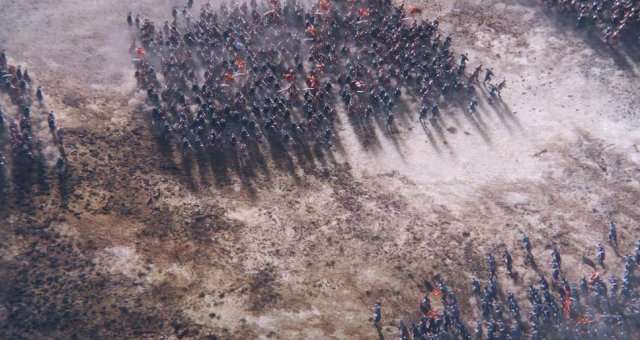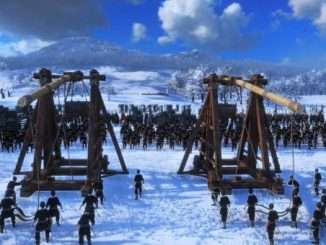
Other Total War: Three Kingdoms Guides:
- Getting Started.
- Beginner’s Guide (Tips and Tricks).
- Advanced Tips and Tricks.
- Damage Types and Effects.
- Spies & Espionage Guide.
- Zone of Control Guide.
- Administrators Guide.
- Commandery Guide.
- Fortifications Guide.
- Formations Guide.
- Diplomacy Guide.
- Factions Guide.
- Terrain Guide.
- Fatigue Guide.
- Morale Guide.
- Armies Guide.
- Unit Abilities.
- Battle Types.
- Court Guide.
- Duels Guide.
- Unit Types.
Siege
All credit goes to CA_OtherTom!
A walled settlement, such as a large commandery capital, cannot be immediately attacked unless the attacking army has artillery. Without artillery, the settlement must be besieged for a number of turns first in order for the attacker to assemble siege equipment. A siege distresses the settlement and its defenders over time, and runs down the attacking army’s military supplies.
When you order an army to attack a walled settlement, the siege panel will open. This gives you important information about the settlement you’re besieging, which can help guide your approach. The row of icons detail:
- Whether the settlement gates are open or closed. Certain spy actions can open the gates prior to a siege battle, granting access to the attackers.
- The strength of the walls. Walls become weaker each turn as the siege continues.
- The number of turns the settlement will withstand the siege before surrendering. Certain general’s traits and ancillaries may grant longer siege holdout times to the defender, or shorter siege holdout times for the attacker.
- The number of turns under siege before the settlement runs out of supplies.
- The presence of any barricades or bastion artillery, which will be employed by the defender when a siege battle is initiated by the attacker.
The panel also offers the construction of siege equipment to enable you to attack and penetrate the city.
In subsequent turns of the siege, the attacker can reopen the siege panel by clicking the siege icon next to the stettlement, or by selecting the attacking army and right-clicking on the settlement as if attacking.
There is a variety of potential outcomes to a siege. A siege battle may be initiated; the defenders may choose to surrender; an army defending the settlement may choose to sally out and engage the attacker; or the attackers may choose to break the siege.
Breaking siege
The attacker may choose to break the siege at any time via the siege panel, prompting the army to move outside the settlement’s zone of control. Any siege equipment already built during the siege will be lost. There are various reasons why the attacker may wish to do this; if their military supplies run out for example and they begin suffering heavy attrition, or if an army friendly to the defender arrives to threaten the attacker, tipping the odds.
Capture points
Each settlement has several different points which the attacker can station his units on to gain control of them.
- Victory points: Each settlement has one victory point. Capturing this will end the battle as a victory for the attackers.
- Gatehouses: Semi-circular capture-points are marked on the ground within the walls of a city, adjacent to each gate. Mousing over a gate will highlight these. If captured, they will grant free access to the attacker through the gate. These points can be recaptured by the defenders.
- Arrow Towers: Semi-circular capture-points are marked on the ground adjacent to each arrow tower. Mousing over arrow towers will highlight these. If captured, the relevant arrow tower will cease firing at the attackers. These points can be recaptured by the defenders.
Escalation
As a settlement on the campaign map endures successive turns under siege, damage will escalate across the settlement. When the battle is initiated, this damage from siege escalation will be visually apparent. Escalation levels rise in line with the number of turns a settlement is under siege, damaging buildings, breaching walls, and causing increasingly severe morale penalties to the defending army when battle is initiated.
Sally out
In some situations, it may be advantageous for an army stationed within a settlement to vacate the city – or ‘sally out’ – to engage the attacking army. If their supplies run low for example, or the settlement becomes so damaged that the negative penalties from escalation will severely hinder it in a siege battle.
If the defending stationed army chooses to sally out, the settlement’s garrison force (and any other friendly armies within the settlement’s zone of control) will join it in an open land battle against the attacker in front of the city.
Likewise, if a friendly army enters the settlement’s zone of control to attack the besieging army, the settlement’s garrison force and any defending army will sally out and join the battle.
Settlement damage
As a settlement undergoes damage through escalation and during a siege battle, specific buildings may become damaged or destroyed. When the siege is over, these buildings will need to be repaired or rebuilt to regain their functionality in the campaign game. To repair a building, click the repair icon on the relevant building slot in the commandery panel.
Supplies
When a settlement is under siege, the commandery becomes cut off from the owner’s factionwide food supply, and its reserves will not replenish. The settlement then has a limited number of turns before it runs out of supplies, which is displayed in the siege panel. When a settlement’s supplies are gone, its garrison force (and any army that is statione in the settlement) will begin to suffer from attrition, damaging all units and reducing their morale when battle commences.
The attacking army must also be mindful of its own military supplies. Successive turns spent in enemy territory besieging a settlement will use up supplies, and low supplies will cause attrition and morale loss to the attackers while the siege continues.
Surrender
The defenders of a settlement under siege may choose to surrender at any time. The likelihood of this increases as the siege continues, and this is marked in the siege panel. This is no gaurantee they will surrender however; they may instead choose to sally out and counterattack.
Walls
When battle commences, the attacker must overcome the settlement’s walls to enter the city. Walls can be broken down using artillery, and foot soldiers can be ordered to scale the walls. Scaling walls takes time however and climbing soldiers are vulnerable to arrow fire and melee attack when they reach the battlements.
As a settlement is subjected to successive turns under siege on the campaign map, the weaker its walls will become, in line with siege escalation. The weaker its walls, the more easily they will fall to artillery fire when battle commences. At high levels of escalation, some wall sections may already have collapsed when the siege battle is initiated, granting entry to the city in battle.
Walls can also be collapsed prior to battle via sapping.
Siege equipment
If the attacker has no artillery, siege equipment is usually needed to initiate a siege battle against a walled settlement, and the siege panel offers construction orders to the attacker.
Siege equipment takes times to build, and the amount which can be built is defined by the attacker’s construction capacity, as noted in the siege panel. Construction capacity rises in line with the number of men in an army, so bigger armies can build more equipment over time.
Siege equipment orders fall into two categories:
- Battering rams: Any battering rams you build will be assigned to a unit to commandeer when the siege battle is initiated, and may be deployed like any other unit, or even dropped and assigned to a different unit. Battering rams are designed to smash down gates and grant access to the city. In battle, the unit manning a ram may be selected and given an attack command against a gate like any other unit. When a battering ram has smashed through a gate, it’s function has been performed and it cannot be reused.
- Sapping: Each sapping order you give prior to initiating a battle will attack the foundations and collapse a single random section of the settlement’s walls, granting access to your units if a siege battle is initiated.





Be the first to comment